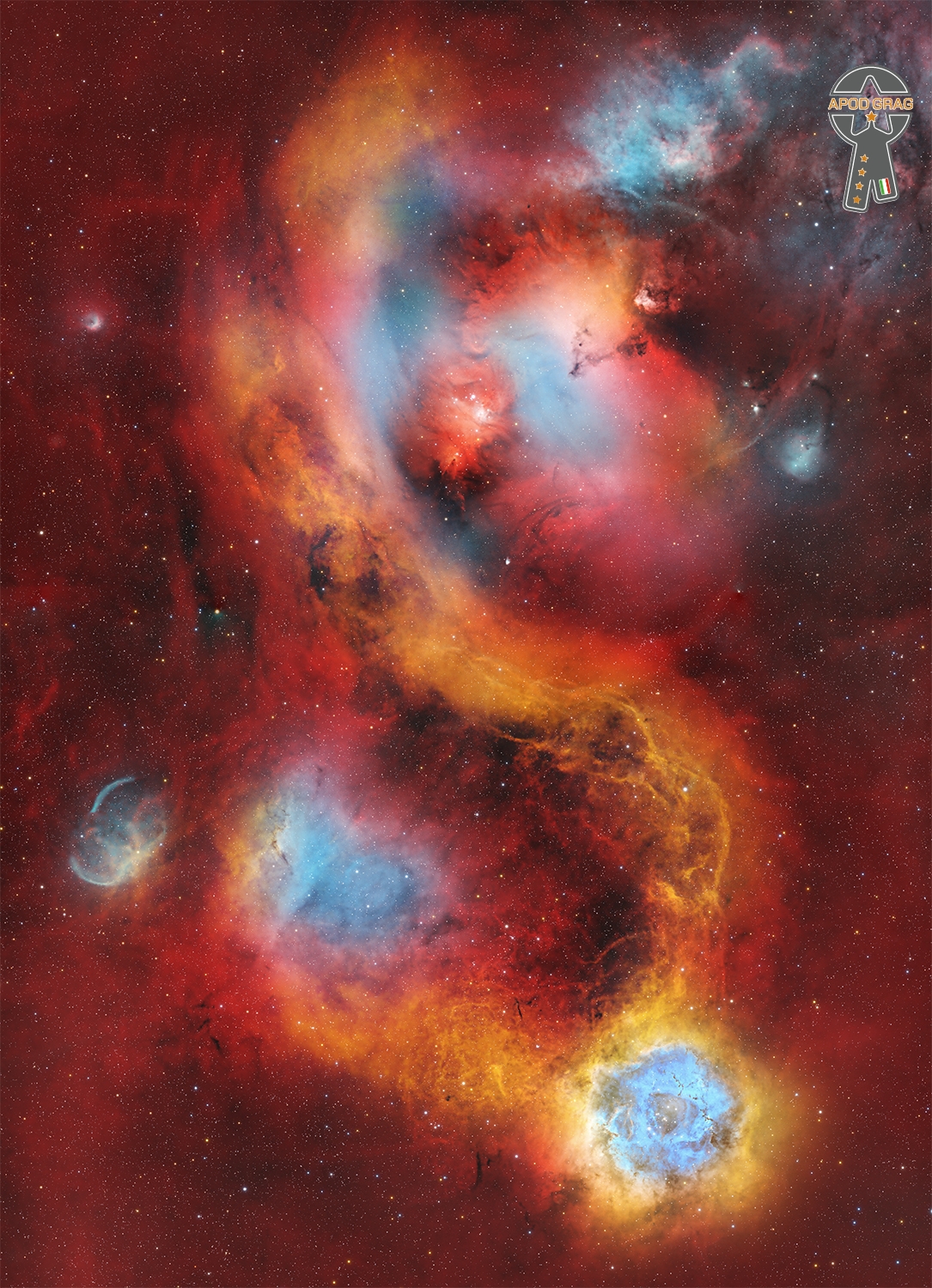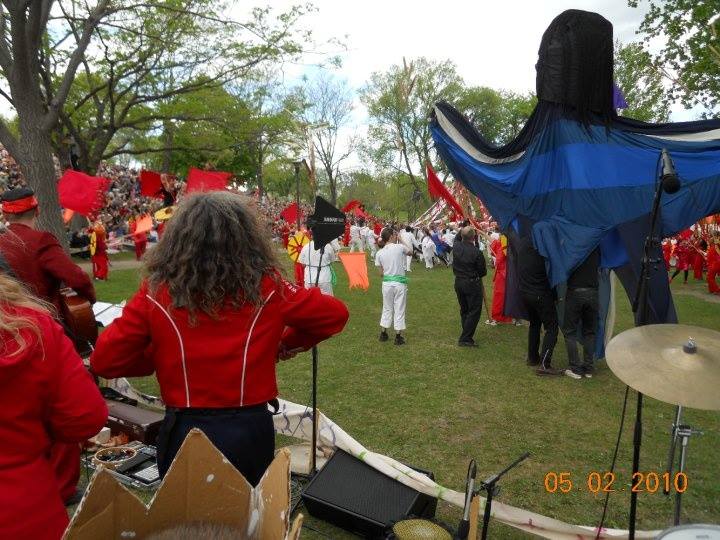Blog
Sharon Lafaye Jones (May 4, 1956 – November 18, 2016) was an American soul and funk singer. She was the lead singer of Sharon Jones & The Dap-Kings, a soul and funk band based in Brooklyn, New York. Jones experienced breakthrough success relatively late in life, releasing her first record when she was 40 years old. In 2014, Jones was nominated for her first Grammy, in the category Best R&B Album, for Give the People What They Want.
more...The new Mayday Celebration this year with a new sponsor SEMILLA CENTER FOR HEALING AND THE ARTS (https://www.semillacenter.org/). Mayday was formally sponsored by In The Heart of the Beast Puppet and Mask Theater for over four decades. The tradition continues with a new generation of artists.
This year featuring Grandma Powderhorn fighting the oppressors of evil. mick will be in the parade with Your Community Band and Percussionist with the Mayday Ceremony Artist team. mick is pictured here in 2016 wearing black on the left bottom of pic.

more...
The constellation of Monoceros (which means “unicorn” in Greek) is located in the northern sky, near other constellations such as Orion and Canis Major. This region is especially known for containing several bright nebulae, such as the Rosette Nebula and the Christmas Tree Nebula, as well as other interesting star formations.
1. The Rosette Nebula The Rosette Nebula (NGC 2237-2246) is a large emission nebula located in the constellation of Monoceros, about 4,500 light-years from Earth. It is one of the most famous and studied nebulae due to its impressive spiral shape, which resembles a rose (hence its name). This nebula is a huge reservoir of gas and dust, where new stars are born.
Characteristics: The nebula has a diameter of about 130 light-years. At its center is the star cluster NGC 2244, composed of hot, young stars that have ionized the surrounding gas, creating the bright glow that makes it visible. The nebula is filled with dense gas and dust, which are actively forming new stars.
2. The Christmas Tree Nebula The Christmas Tree Nebula (also known as NGC 2264) is a star-forming region located near the Rosette Nebula, in the constellation of Monoceros. It is located about 2,700 light-years from Earth and is famous for its appearance, with a structure of gas and dust resembling a Christmas tree.
Characteristics: This nebula is a region of active star formation. The star cluster NGC 2264, within the nebula, is composed of young stars, some of which are in the early stages of star formation. The structure, which resembles a Christmas tree, is a formation of gas and dust illuminated by radiation from newly formed stars.
3. Supernova Remnant (SNR G206.0+0.3) Monoceros also contains a supernova remnant known as SNR G206.0+0.3. This remnant is what remains after a supernova explosion, where a massive star has exploded, releasing enormous amounts of energy and material into space.

Richard Anthony Monsour (May 4, 1937 – March 16, 2019), known professionally as Dick Dale, was an American rock guitarist. He was a pioneer of surf music, drawing on Middle Eastern music scales and experimenting with reverb. Dale was known as “The King of the Surf Guitar”, which was also the title of his second studio album.
Dale was one of the most influential guitarists of all time and especially of the early 1960s. Most of the leading bands in surf music, such as The Beach Boys, Jan and Dean and The Trashmen, were influenced by Dale’s music, and often included recordings of Dale’s songs in their albums. His style and music influenced guitarists such as Jimi Hendrix, Pete Townshend, Eddie Van Halen and Brian May.
He has been credited with popularizing tremolo picking on electric guitar, a technique that is now widely used in many musical genres (such as extreme metal, jazz fusion, etc.). His speedy single-note staccato picking technique was unrivaled until guitarists like Eddie Van Halen entered the music scene.
He is cited as one of the fathers of heavy metal for pushing the limits of amplification. Working together with Leo Fender, Dale helped to develop new equipment that was capable of producing thick and previously unheard volumes including the first-ever 100-watt guitar amplifier. Dale also pioneered the use of portable reverb effects.
The use of his recording of “Misirlou” by Quentin Tarantino in the film Pulp Fiction led to his return in the 1990s, marked by four albums and world tours. He was also nominated for a Grammy in the Best Rock Instrumental Performance category for the song “Pipeline” with Stevie Ray Vaughan. In “Rolling Stone’s 100 Greatest Guitarists of All Time”, Dale was ranked 31st in 2003 and 74th in the 2011 revision.
more...Sonny Payne (May 4, 1926 – January 29, 1979) was an American jazz drummer, best known for his work with Count Basie and Harry James.
Payne’s father was Wild Bill Davis‘s drummer Chris Columbus. After early study with Vic Berton, in 1944 Payne started playing professionally around New York with the Dudand Paul Bascomb band, Hot Lips Page, Earl Bostic (1945–1947), Tiny Grimes(between 1947 and 1950), and Lucille Dixon (1948).
more...
Umm Kulthum (Arabic: أم كلثوم; 31 December 1898 – 3 February 1975) was an Egyptian singer, songwriter, and film actress active from the 1920s to the 1970s. She was given the honorific title Kawkab el-Sharq (Arabic: كوكب الشرق, lit. ‘Star of the Orient’). Immensely popular throughout the Middle East and beyond, Umm Kulthum is a national icon in her native Egypt; she has been dubbed “The Voice of Egypt” and “Egypt’s Fourth Pyramid“. In 2023, Rolling Stone ranked Umm Kulthum at number 61 on its list of the 200 Greatest Singers of All Time.
Her funeral in 1975 drew a crowd of over 4 million people, the largest human gathering in Egypt’s history, even surpassing that of president Gamal Abdel Nasser.
more...Sadguru Tyagaraja Swami (Telugu: సద్గురు త్యాగరాజ స్వామి; 4 May 1767 – 6 January 1847), also known as Tyagayya, and in full as Kakarla Tyagabrahmam (Telugu: కాకర్ల త్యాగబ్రహ్మం), was a Hindu saint and composer of Carnatic music, a form of Indian classical music. Tyagaraja and his contemporaries, Shyama Shastri and Muthuswami Dikshitar, are regarded as the Trinity of Carnatic music. Tyagaraja composed hundreds of devotional compositions, most in Telugu and in praise of Rama, many of which remain popular today. Of special mention are five of his compositions called the Pancharatna Kritis (transl. “five gems”), which are often sung in programs in his honour. Tyagaraja composed Utsava Sampradaya Krithis (transl. Festive ritual compositions), which are often sung to accompany temple rituals and Divya Nama Sankeertanas (transl. Divine name compositions) which are sung as a part of concerts and in daily life.
Tyagaraja lived through the reigns of four kings of the Maratha dynasty – Thuljaji (1763–1787), Amarasimha (1787–1798), Serfoji II (1798–1832) and Shivaji II (1832–1855),although he served none of them.
more...Ronald Levin Carter (born May 4, 1937) is an American jazz double bassist. His appearances on 2,221 recording sessions make him the most-recorded jazz bassist in history. He has won three Grammy Awards, and is also a cellist who has recorded numerous times on the instrument. In addition to a solo career of more than 60 years, Carter is well-known for playing on numerous iconic Blue Note albums in the 1960s, as well as being the anchor of trumpeter Miles Davis‘s “Second Great Quintet” from 1963-1968.
Beginning with Where? in 1961, Carter’s studio albums as leader also include Uptown Conversation (1969), Blues Farm (1973), All Blues (1973), Spanish Blue (1974), Anything Goes (1975), Yellow & Green (1976), Pastels (1976), Piccolo (1977), Third Plane (1977), Peg Leg (1978), A Song for You (1978), Etudes (1982), The Golden Striker (2003), Dear Miles (2006), and Ron Carter’s Great Big Band (2011).
more...Saturday May 3rd 2025. The final performance of Italian Baroque Chaconnes at Mt Olive Lutheran Church in Minneapolis at 3pm by the Early Music Minnesota ensemble. With guest percussionist mick laBriola.

Messier 94 (also known as NGC 4736, Cat’s Eye Galaxy, Crocodile Eye Galaxy, or Croc’s Eye Galaxy) is a spiral galaxy in the mid-northern constellation Canes Venatici. It was discovered by Pierre Méchain in 1781, and catalogued by Charles Messier two days later. Although some references describe M94 as a barred spiral galaxy, the “bar” structure appears to be more oval-shaped. The galaxy has two ring structures. 16mly.

Betty Comden (May 3, 1917 – November 23, 2006) was an American lyricist, playwright, and screenwriter who contributed to numerous Hollywood musicals and Broadway shows of the mid-20th century. Her writing partnership with Adolph Greenspanned six decades: “the longest running creative partnership in theatre history.” The musical-comedy duo of Comden and Green collaborated most notably with composers Jule Styne and Leonard Bernstein, as well enjoyed success with Singin’ in the Rain, as part of the famed “Freed unit” at Metro-Goldwyn-Mayer.
more...Peter Seeger (May 3, 1919 – January 27, 2014) was an American singer, songwriter, musician, and social activist. He was a fixture on nationwide radio in the 1940s, and had a string of hit records in the early 1950s as a member of The Weavers, notably their recording of Lead Belly‘s “Goodnight, Irene“, which topped the charts for 14 weeks in 1950. Members of the Weavers were blacklisted during the McCarthy Era. In the 1960s, Seeger re-emerged on the public scene as a prominent singer of protest music in support of international disarmament, civil rights, workers’ rights, counterculture, environmental causes, and ending the Vietnam War.
Among the prolific songwriter’s best-known songs are “Where Have All the Flowers Gone?” (with additional lyrics by Joe Hickerson), “If I Had a Hammer (The Hammer Song)” (with Lee Hays of the Weavers), “Kisses Sweeter than Wine” (also with Hays), and “Turn! Turn! Turn! (To Everything There Is a Season)”, which has been recorded by many artists both in and outside the folk revival movement. “Flowers” was a hit recording for The Kingston Trio (1962); Marlene Dietrich, who recorded it in English, German and French (1962); and Johnny Rivers (1965). “If I Had a Hammer” was a hit for Peter, Paul and Mary (1962) and Trini Lopez (1963) while The Byrds had a number one hit with “Turn! Turn! Turn!” in 1965.
Seeger was one of the folk singers responsible for popularizing the spiritual “We Shall Overcome” (also recorded by Joan Baez and many other singer-activists), which became the acknowledged anthem of the civil rights movement, soon after folk singer and activist Guy Carawan introduced it at the founding meeting of the Student Nonviolent Coordinating Committee (SNCC) in 1960. In the PBS American Mastersepisode “Pete Seeger: The Power of Song“, Seeger said it was he who changed the lyric from the traditional “We will overcome” to the more singable “We shall overcome”.
more...James Joseph Brown (May 3, 1933 – December 25, 2006) was an American singer, songwriter, dancer, musician, and record producer. The central progenitor of funk musicand a major figure of 20th-century music, he is referred to by various nicknames, among them “Mr. Dynamite”, “the Hardest-Working Man in Show Business”, “Minister of New Super Heavy Funk”, “Godfather of Soul”, “King of Soul”, and “Soul Brother No. 1”. In a career that lasted more than 50 years, he influenced the development of several music genres. Brown was one of the first ten inductees into the Rock and Roll Hall of Fameon January 23, 1986. His music has been heavily sampled by hip-hop musicians and other artists.
Brown began his career as a gospel singer in Toccoa, Georgia. He rose to prominence in the mid-1950s as the lead singer of the Famous Flames, a rhythm and blues vocal group founded by Bobby Byrd. With the hit ballads “Please, Please, Please” and “Try Me“, Brown built a reputation as a dynamic live performer with the Famous Flames and his backing band, sometimes known as the James Brown Band or the James Brown Orchestra. His success peaked in the 1960s with the live album Live at the Apollo and hit singles such as “Papa’s Got a Brand New Bag“, “I Got You (I Feel Good)” and “It’s a Man’s Man’s Man’s World“.
During the late 1960s, Brown moved from a continuum of blues and gospel-based forms and styles to a new approach to music-making, emphasizing stripped-down interlocking rhythms that influenced the development of funk music. By the early 1970s, Brown had fully established the funk sound after the formation of the J.B.s with records such as “Get Up (I Feel Like Being a) Sex Machine” and “The Payback“. He also became noted for songs of social commentary, including the 1968 hit “Say It Loud – I’m Black and I’m Proud“. Brown continued to perform and record until his death from pneumonia in 2006.
Brown recorded and released 17 singles that reached No. 1 on the Billboard R&B charts. He also holds the record for the most singles listed on the Billboard Hot 100chart that did not reach No. 1. Brown was posthumously inducted into the first class of the Rhythm & Blues Music Hall of Fame in 2013 as an artist and then in 2017 as a songwriter. He received honors from several other institutions, including inductions into the Black Music & Entertainment Walk of Fame and the Songwriters Hall of Fame. In Joel Whitburn‘s analysis of the Billboard R&B charts from 1942 to 2010, Brown is ranked No. 1 in the Top 500 Artists. He is ranked seventh on Rolling Stone‘s list of the 100 Greatest Artists of All Time,[15] and at No. 44 on their list of the 200 Greatest Singers of All Time.
more...John Aaron Lewis (May 3, 1920 – March 29, 2001) was an American jazz pianist, composer and arranger, best known as the founder and musical director of the Modern Jazz Quartet. Once Lewis moved to New York, Clarke introduced him to Dizzy Gillespie‘s bop-style big band. He successfully auditioned by playing a song called “Bright Lights” that he had written for the band he and Clarke played for in the Army. The tune he originally played for Gillespie, renamed “Two Bass Hit”, became an instant success. Lewis composed, arranged and played piano for the band from 1946 until 1948 after the band made a concert tour of Europe. When Lewis returned from the tour with Gillespie’s band, he left it to work individually. Lewis was an accompanist for Charlie Parker and played on some of Parker’s famous recordings, such as “Parker’s Mood” (1948) and “Blues for Alice” (1951), but also collaborated with other prominent jazz artists such as Lester Young, Ella Fitzgerald and Illinois Jacquet.
more...
More Posts
- Mardi Gras Sunday 2020
- The Cosmos with NGC 4689
- Wayne Escoffery Day
- Rusty Young Day
- Johnny Winter Day
- George Frideric Handel Day
- World Music with Vikku Vinayakram
- Daily Roots with Jacob Miller
- Mardi Gras Weekend 2020
- The Cosmos with NGC 5128
- Joe LaBarbera Day
- Ernie K Doe Day
- Joe Wilder Day
- Buddy Tate Day
- World Music with Manhu Band
- Daily Roots with the Selector
- Shabbat for the Soul @ Mt Zion
- The Cosmos with LDN 1622
- Corey Harris Day
- Nina Simone Day

